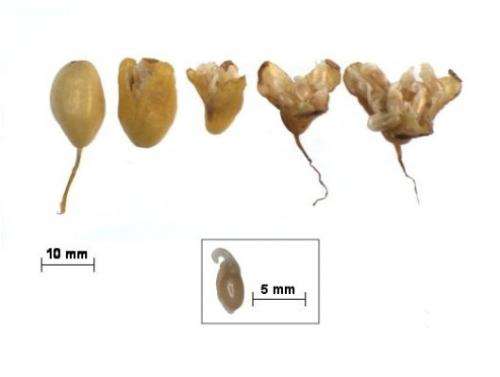New typology of seed development in late winter-flowering temperate woodland plants

The welcome sight of snowdrops and daffodils coming into flower in the late winter herald the promise of spring warmth just around the corner. These plants are adapted to flower early in the year to take advantage of the limited sunlight that reaches the woodland understorey before trees come in to leaf. A consequence of this behaviour is that flowering is prolonged and seed development occurs especially slowly because of the cold temperatures.
Now, research at the Millennium Seed Bank (RBG Kew) at Wakehurst Place in West Sussex and the University of Reading has shown an unusual adaptation of seed development and maturation to this niche at the opposite end of the reproductive period. Seeds disperse when still immature, and very moist, onto the forest floor. The concomitant closure of the tree canopy and increased shading as the undergrowth thickens creates a humid microcosm in which embryos continue to develop within seeds throughout the summer, with germination occurring with the drop in temperature in the autumn.
During seed development, the ability of seeds to germinate develops a few weeks before seeds are dispersed. Yet the capacity of these seeds to survive desiccation to the low moisture contents routinely used in seed banking is limited, and only evident just prior to seed shed. Knowledge of the sensitivity of seeds of these species to rapid drying has highlighted the importance of collecting seeds as close to the point of natural dispersal as possible, to maximise the potential of seeds to tolerate drying.
This research has identified a new typology of seed development, with application more widely to species adapted to similar seasonally-short niches compromised by low temperature and competition for light. Furthermore, it has improved our understanding of these species' adaptation to their habitat, and this knowledge will aid the successful conservation of these, and seeds of similar species, in the Millennium Seed Bank.
More information: Newton, R., Hay, F. & Ellis, R. (2013) Seed development and maturation in early spring-flowering Galanthus nivalis and Narcissus pseudonarcissus continues post-shedding with little evidence of maturation in planta. Annals of Botany 111: 945-955. aob.oxfordjournals.org/content/111/5/945.full
Journal information: Annals of Botany
Provided by Royal Botanic Gardens, Kew











.jpg)






